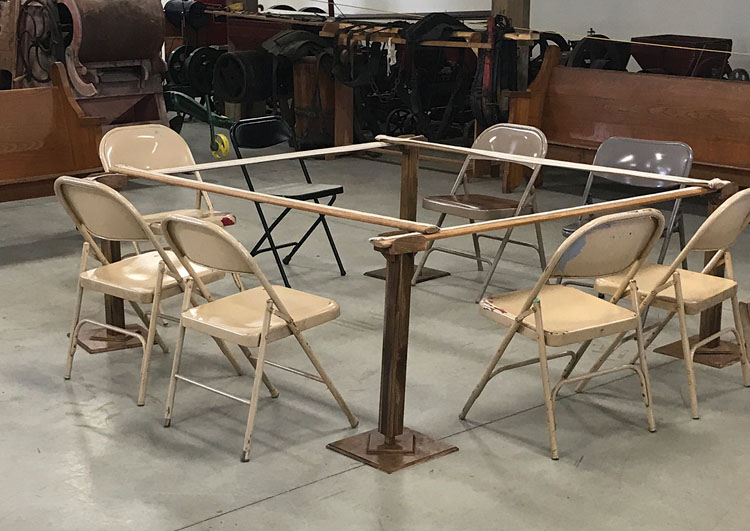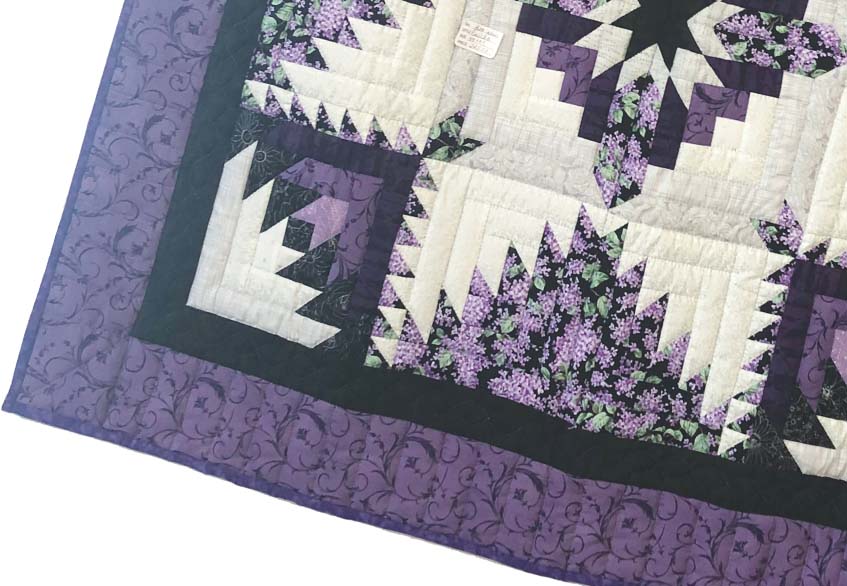How did you get started in quilting?
I started quilting because I loved to sew. When I was a kid with Mom, she’d sit at the quilt frame beside me and show me how to do it. Actually, I started sewing on the sewing machine first, on my own, making doll dresses, and so forth. I practiced on my own. Mom made quilts for the family-for the boys and girls when they got married. There were eleven of us. I think maybe the boys got one quilt and the girls got two. Mom’s sister pieced the tops together, and then she has a quilting bee with her sisters or aunts or cousins, to finish the quilt. At a quilting bee, you can almost do a quilt in a day, rather than the three to four weeks working alone. As I got older, I only quilted at quilting bees. I was the oldest daughter, so I sewed for the entire family. I really never thought I’d be doing quilting for sale someday.

How did you get started in the quilt business?
Around 1973 or 1974, after I got married, I took work making quilts in my house and quilted for another lady for a couple of years. I loved it. Then, I started making pillows and small crafts to sell to different shops until 1982, when I started my own shop. My mother-in-law helped me get started.
Briefly describe the steps in making a quilt.
First, you pick the design or pattern you want, and then you put the materials and colors together. Next, you cut the pieces and sew them together. After that, you use a stencil to mark them out with a pencil where they get quilted. Now you can put the bottom piece, the batting, and the top piece together onto the quilting frame. As you sew, you must be careful to go through all three layers. When you finish, you take the quilt out of the frame, cut a straight or scalloped edge, and put the binding on.
How do you decide on patterns?
I never really tried to do that myself. But if a new pattern comes out, we’ll try to improve it, like choosing different colors. For two or three years, we sold very few appliques. The Dahlia pattern was the most popular one for three years. But in 1993 I sold a lot of applique quilts, which are the most expensive. I also have a lot more quilts with newer colors. The Hoffman print material has been very popular. The Amish nowadays use the traditional solid colors less and use prints more. But I wanted to make sure that my boys get a Sunshine and Shadow quilt. I don’t want to lose that. For the boys, I also like the Log Cabin and Irish Chain Patterns. I hope to make three quilts for my daughter and two for each of my three boys when they get married. Grandmother has also been giving quilts to her grandchildren when they turn 15 or 16.
How do the men folk feel about the quilt business?
Most men support us, and some are very involved in the quilt business. As far as owning a shop is concerned, it can sometimes intrude on family life. A mother is supposed to be a housewife…cook, sew the clothes, etc. Quilting and a shop can come between things, and the family comes to understand that. But it can be frustrating when I’m not there and they need something. Two of my boys don’t have interest in the shop, but my other two children help sometimes. My husband works as a painting contractor.
What would you like people to know about Amish quilts?
Why do quilts cost what they do? Most people have no idea how much time it takes to make a quilt, to do each stitch by hand. More people are trying to make their own quilts now, and their finding it’s harder than they thought it was. You have to enjoy quilting while you’re doing it, or you won’t be successful. With the quilts I sell, the piecing is done by one person, and the quilting by another. It seems nice when one person makes the entire quilt, but it’s good to have one person do the part that they’re good at. If can stick with one thing, and do it again and again, you get better at it that way.
What’s new in quilting?
Well, I changed my treadle sewing machine to an electric one, powered by compressed air. Of course, applique is still all done by hand, but patchwork is done on the machine and then quilted by hand. Quillows are fairly new. The girl who makes mine for the shop first saw them in Ohio about four or five years ago. She may even have been the first Amish girl in Lancaster County to make them. A quillow is a pillow with a lap-throws sized comforter inside. On the sofa, it looks just like a pillow, but when you open it up it’s a comforter. A friend of mine took one on a trip to Florida. She used it as a back pillow on the way down and then used it as a blanket when she got cold. We’ve also had quilted table runners and placemats for a couple of years.
Do quilts have sentimental value to the Amish?
Most Amish people were farmers and they needed money, so many sold their old quilts to collectors who came around. I remember one year there was a man who seemed to have gone to every house buying quilts! So, although a quilt has sentimental value, some parted with them for the money. My grandmother parted with her quilts, and she was sorry she did. Now we can make quilts to sell. I’ll always hang onto my mother’s Sunshine and Shadow quilt. My aunt pieced that one together, and she’s not here anymore. It’s got sentimental value to me, and I’ll keep it.
Could you describe some proper quilt care?
Quilts are works of art, the tiny intricate stitches are a result of hours and hours of work., not to mention years of training. With care, the beauty of a handmade quilt can be preserved for several generations to enjoy. Quilt fabric today is almost always 100 percent cotton or a cotton-polyester blend, both of which are machine-washable. The batting, or filling in the quilts, is usually machine-washable polyester. But since quilts are held together with tiny quilting stitches, it’s a good idea to use caution when washing. If you do machine-wash quilts, do so on a gentle cycle in cold water to prevent shrinkage. And if the quilt has dark colors, it should be properly dry-cleaned to prevent the colors from bleeding. If they are machine-dried, the dryer should be set on a low setting.
The quilt may also be hung outdoors, preferably over several clotheslines to distribute the weight, or dried flat on the grass with towels underneath. If a quilt is stored, it should be rolled instead of folded to prevent permanent creases. If it must be folded because of space limitations, take it out several times a year and refold it. Never store a quilt in plastic. Instead, store it in a sheet or pillowcase that allows air to circulate around it, and be sure it is protected from insect damage.
We wish to thank the interviewee and regret that the comments about her noisy parrot could not be included in this interview. This was an interview that was cultivated back in March of 2000, but as with Amish Quilts that bode well with the quality of craftsmanship and time, so too – in our thoughts – does this glance back in time with this special article. We hope you enjoyed it as much as we did in refreshing it up for you.
the Amish County News Editors

